Discover the captivating world of Bat Trang Pottery Village, a historic haven nestled near Hanoi, Vietnam, celebrated for its exquisite ceramics and profound cultural heritage. This village, rooted deeply in tradition, offers a nuanced journey through centuries-old pottery-making practices and modern innovations. As a reader, you’re about to delve into the origins, artistic techniques, and cultural nuances that make Bat Trang a unique tapestry of craftsmanship. Explore the stories behind the glazes, the evolution of techniques, and the vibrant community efforts ensuring sustainability in every piece of pottery.
Watch the video summarizing the article “Bat Trang Pottery Village: Craftsmanship, Culture, and Sustainability”
History of Bat Trang Pottery Village
The history of Bat Trang Pottery Village is a compelling tale of innovation interwoven with tradition. Situated mere kilometers away from Hanoi, the village’s ceramic roots trace back over seven centuries to the Ly Dynasty. During this era, artisans established Bat Trang as a center for superior pottery, renowned for its striking designs and durable wares. Over the centuries, Bat Trang evolved, enduring political upheavals and economic shifts, yet retained its status as a cultural and artistic beacon. Its history is rich with the transitions from traditional crafting to the adoption of modern techniques.
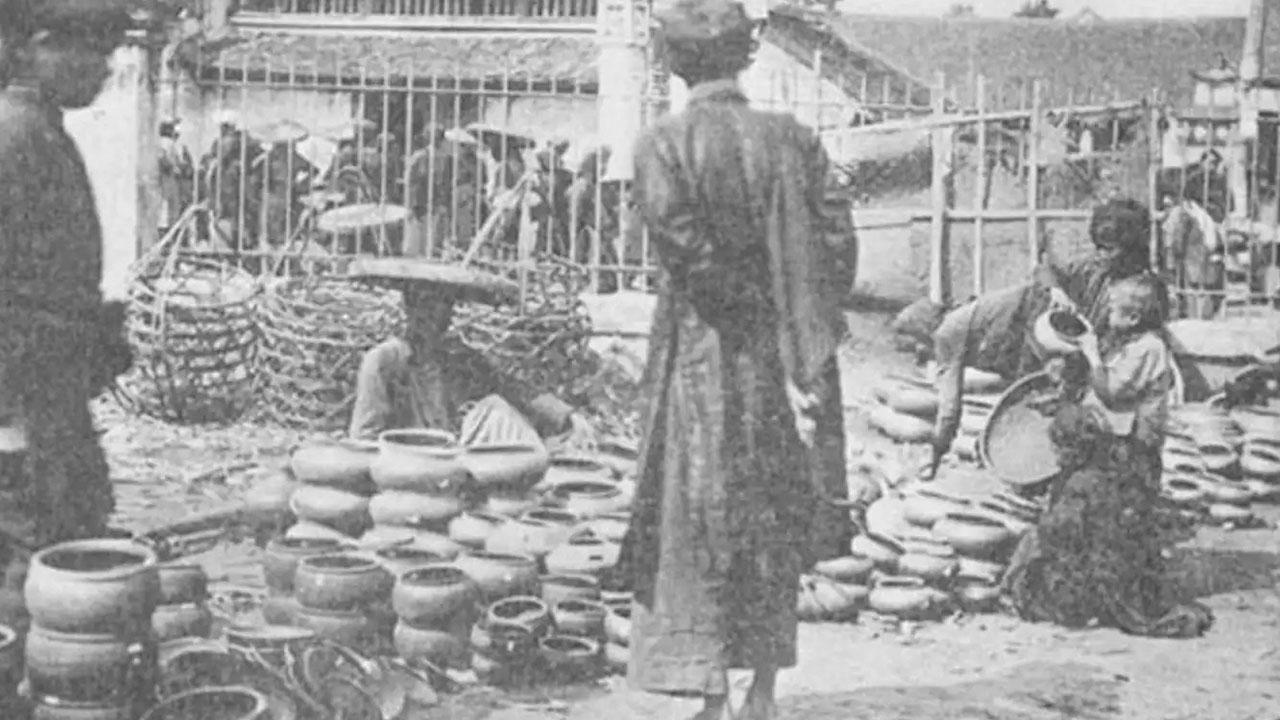
Origin of Bat Trang Pottery
Bat Trang’s origins are steeped in legend and lore, offering a glimpse into a bygone era where artistry and trade converged. Established by skilled craftsmen during the Ly Dynasty, this village emerged as a bustling hub for pottery due to its strategic location near the Red River, facilitating trade and resource access. Here, artisans harnessed local clay resources, an exquisite white clay ideal for producing robust and intricate ceramic pieces.
The founding families, known for their pottery skills, recognized the area’s potential. Names such as Tran, Le, and Nguyen resonate within the village’s history, each contributing to the burgeoning craft scene. Initially, the village crafted utilitarian items, reflecting everyday needs. However, as time progressed, creative expressions flourished, infusing the ceramics with cultural narratives and artistic flair, something that remains evident in contemporary pieces.
Another significant development was the introduction of the celadon glaze from China, enhancing the visual appeal of Bat Trang’s pottery with its lustrous, jade-like finish. This period marked a shift from purely functional products to decorative and symbolic items, highlighting stories and spiritual motifs. Thus, Bat Trang was not just a production center but became a storyteller through ceramics, embedding tradition and modernity into each piece’s core.
Bat Trang’s establishment was not merely a reaction to environmental or economic needs; it represented a burgeoning cultural identity. It forged a community around pottery, one that thrived on shared techniques and collective learning, culminating in a legacy that continued to evolve through Vietnam’s dynastic changes.
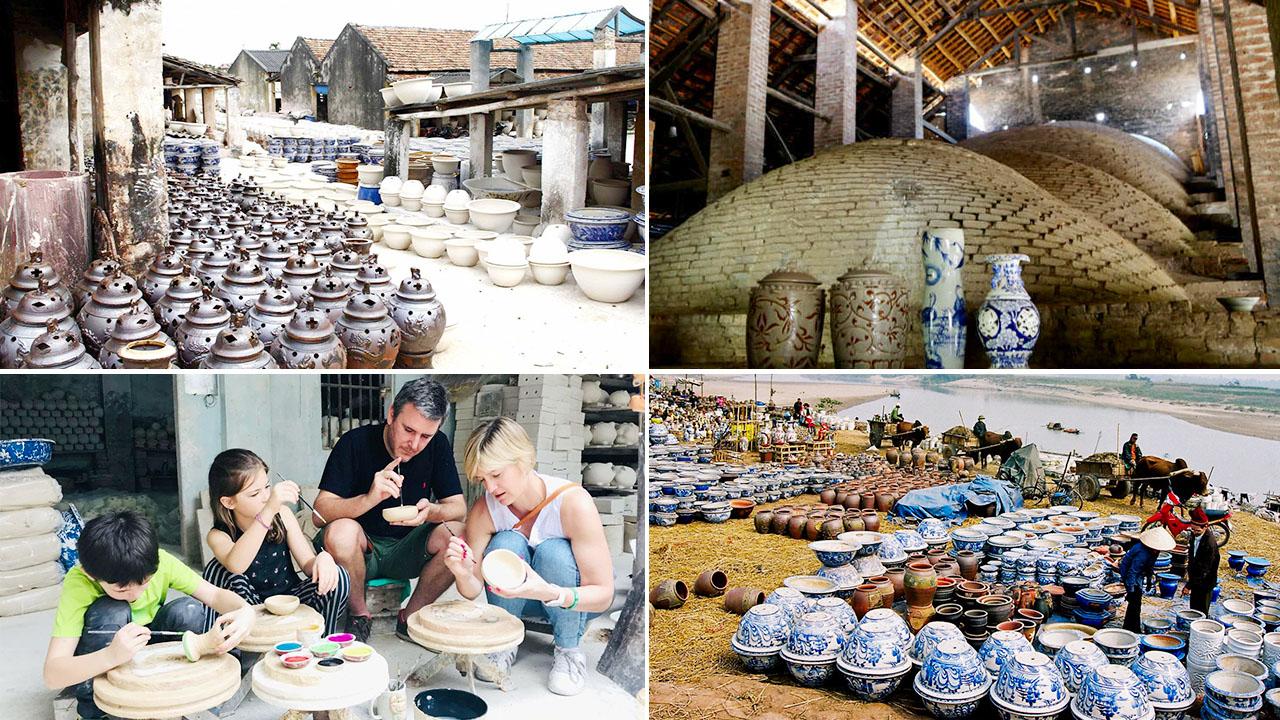
Evolution of Pottery Techniques in Bat Trang
As you dive into the evolving techniques of Bat Trang, it becomes evident that innovation is as much a part of the village’s legacy as tradition. From the initial stages of molding clay by hand to the adoption of the pottery wheel introduced under the influence of Chinese artisans, Bat Trang’s artisans have consistently embraced new techniques. The pottery wheel, in particular, revolutionized production, allowing for more symmetrical and varied forms, from vases to elaborate bowls.
Bat Trang’s technical evolution didn’t stop with shaping clay. The village embraced advanced glazing techniques, moving from basic ash glazes to sophisticated ones incorporating cobalt and manganese. These allowed for vibrant color palettes that became a hallmark of Bat Trang pottery. Also noteworthy is the kiln evolution from open pit firing to the dragon kilns that could reach higher temperatures, producing the durable ceramics that Bat Trang is famed for.
The resilience of Bat Trang’s potters is reflected in their ability to integrate modern innovations while preserving historic methods. In recent years, modern technology has seamlessly blended with tradition. Electric kilns, capable of precise temperature control, have largely replaced traditional wood-fired kilns, not only improving quality but also reducing environmental impact. This duality of preserving ancient methods while embracing technological advancement ensures Bat Trang’s pottery remains relevant and revered.
Visitors witnessing the processes will recognize how techniques have been adapted to meet modern demands without sacrificing the village’s artistic soul. As one learns more about Bat Trang, it is clear that the artisans here do not merely create ceramics; they craft a rich cultural tapestry that invites both admiration and curiosity. Bat Trang is where history and modernity yield an artistic diaspora celebrated worldwide.

Historical Significance of Bat Trang
Bat Trang holds a unique position in Vietnamese history, serving as a vivid reflection of the country’s cultural evolution. The ceramics from this village are not mere objects; they are historical signposts, mirroring societal changes over time. During the Ly Dynasty, Bat Trang’s pottery was revered for its aesthetic and functional value, often gifted to foreign dignitaries as a symbol of goodwill and craftsmanship. As Vietnam navigated through the Le and Nguyen Dynasties, the ceramics evolved but retained their central role in cultural exchanges and domestic rituals.
The significance of Bat Trang pottery extends to its use in religious and ceremonial contexts. Items like incense burners and ceremonial vases found in temples and homes alike signify the importance of spirituality and community in Vietnamese culture. These artifacts tell stories of past rituals and ceremonies, providing intricate designs that reflect the blending of artistic endeavor and spiritual devotion.
Moreover, Bat Trang’s resilience during foreign occupations and economic fluctuations further underlines its historical importance. Despite these challenges, the village continued to produce ceramics that retained traditional motifs while integrating new influences. This adaptability showcases Bat Trang not merely as a pottery village but as a symbol of cultural perseverance.
Today, Bat Trang’s historical and cultural narratives are encapsulated in every piece of pottery, drawing both locals and tourists who seek to understand Vietnam’s rich heritage. The village’s historical significance is a living narrative, continuously shaped by the artisans who bridge the past with the present through their craft.
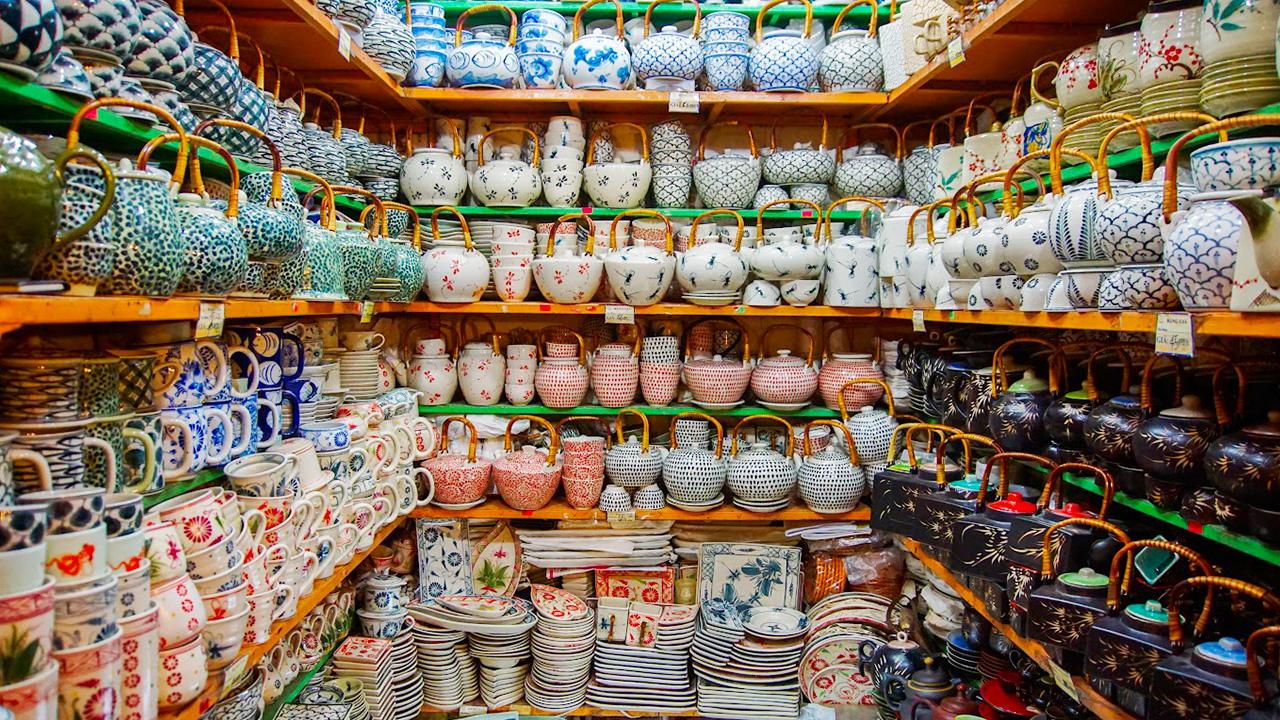
Bat Trang Pottery Techniques
Understanding the techniques employed by Bat Trang artisans provides insight into the craftsmanship that has propelled the village to international acclaim. Spanning centuries, these techniques have been refined and redefined, ensuring the continuity and relevance of Bat Trang’s unique ceramic heritage. Each piece mirrors this careful blend of tradition and modernity, holding within it the story of an enduring craft.
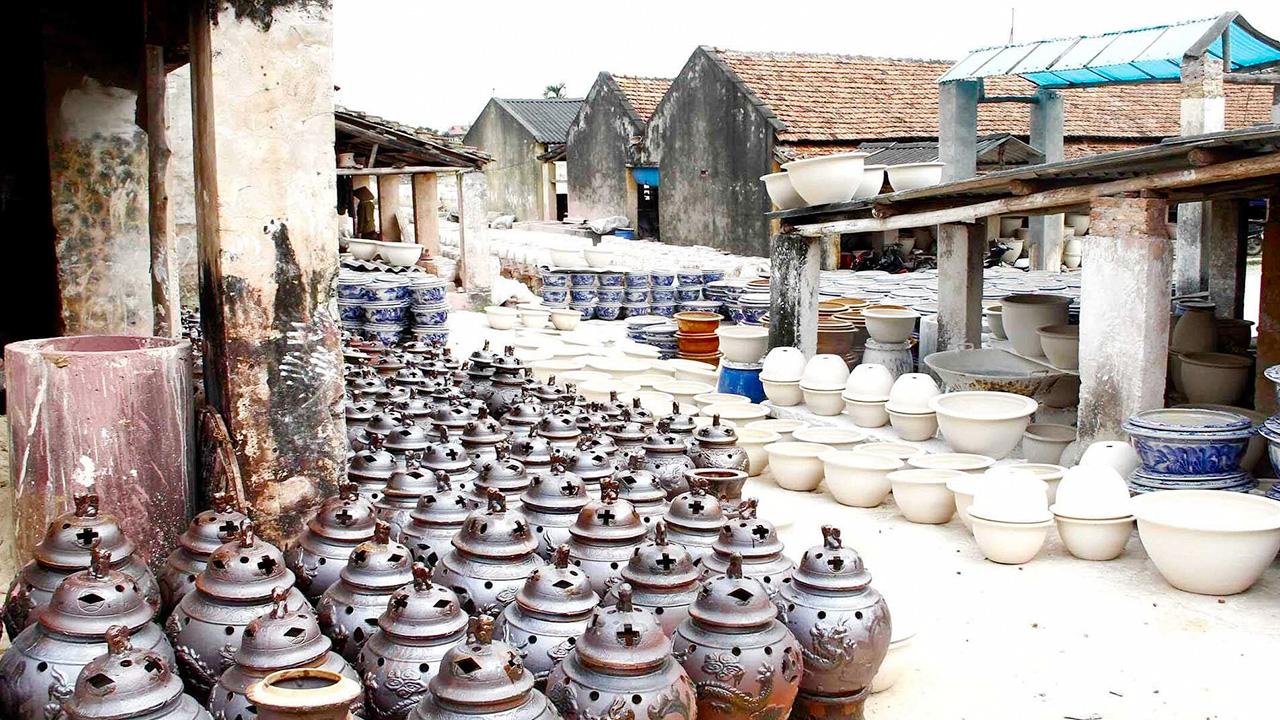
Traditional Pottery Making Methods
At Bat Trang, traditional pottery making is not just a skill; it’s an art form passed down through generations, deeply rooted in cultural heritage. It begins with the clay, sourced locally for its fine texture, which artisans hand-knead to the perfect consistency. This meticulous preparation ensures the clay’s readiness for the pottery wheel, a centerpiece technique in Bat Trang.
The pottery wheel technique, inherited from ancient times, is where artisans shape the spinning clay using skilled hands. This method allows for stunning symmetry and intricate designs, highlighting the craftsman’s precision. Each wheel-thrown piece is unique, revealing the potter’s intuitive touch and expertise in symmetry and form, essential for creating traditional pots and bowls.
Another hallmark method is hand-molding, often used for more intricate decorative items. Here, artisans sculpt the clay manually, often complemented by simple tools to carve delicate patterns and motifs typical of Bat Trang ceramics. This labor-intensive process is revered for producing detailed works of art like statues and bespoke figurines, embodying the artisan’s personal touch and creativity.
The drying and firing process is equally crucial. Initially, pieces are left to dry naturally, ensuring their integrity before firing in kilns. Traditionally, dragon kilns were used, where temperature control was an art itself, ensuring the clay hardened without cracking. Today, electric kilns often replace them, offering more control yet maintaining the traditional firing techniques’ spirit.
Traditional techniques are not just about making ceramics; they are rituals honoring history and culture, ensuring every piece is an homage to Bat Trang’s rich artistic lineage.
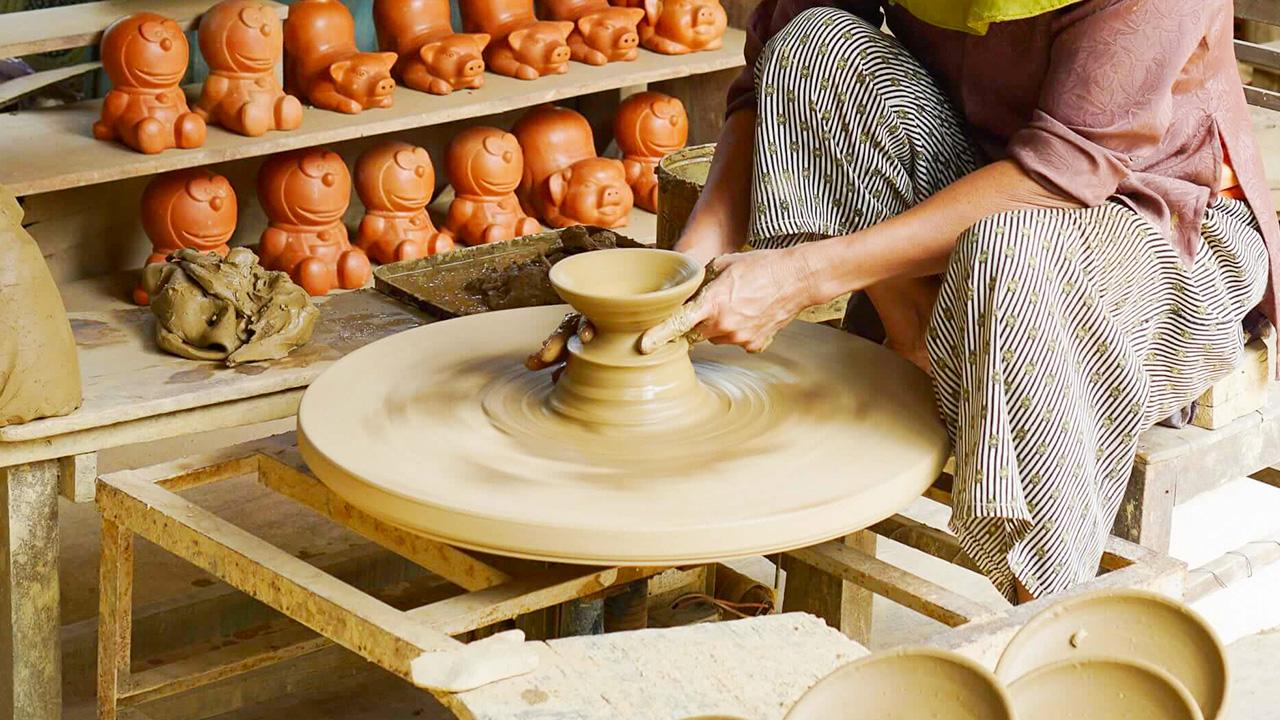
Modern Innovations in Pottery Production
In Bat Trang, the embrace of modern innovations alongside traditional methods creates a fascinating synergy that sustains its global reputation. Advancements in technology have been critical in ramping up production efficiency and expanding the creative capabilities of local artisans.
One significant innovation is the adoption of electric kilns, which offer precise temperature control, crucial for achieving consistent thermal conditions during the glaze applications. This precision ensures high-quality finishes, reducing the risk of imperfections that were harder to control in traditional wood-fired kilns. Moreover, electric kilns support batch production, increasing output and meeting growing global demand without sacrificing quality.
Digital technologies have also permeated Bat Trang’s crafting processes. Computer-aided design (CAD) tools allow for the creation of intricate ceramic patterns, enabling artisans to push creative boundaries further than before. These technologies complement traditional handcrafting methods, offering a new dimension in pottery design that maintains the authentic Bat Trang aesthetic.
Another modern stride is 3D printing technology, an avant-garde approach marrying tradition with innovation. By layering clay through 3D printers, artisans can produce complex forms and unique textures, pushing the frontier of what’s possible in ceramic art. This not only enhances creativity but also enables custom orders based on precise specifications, opening new markets internationally.
These modern innovations signify more than technological adoption; they represent Bat Trang’s adaptability and foresight in remaining a leader in ceramic artistry. The artisans’ openness to new ideas ensures the village remains at the forefront of innovation without departing from its cultural essence.

Unique Glazing Techniques Used in Bat Trang
The glazing techniques used in Bat Trang pottery are emblematic of the village’s artistic richness and technical mastery. These techniques involve both ancient methods and contemporary innovations, resulting in distinctive finishes that define Bat Trang ceramics’ aesthetic appeal.
A prominent technique is the earth-based glazes, which use natural materials creating a signature earthy tone in the final products. This method links the process with nature, reflecting the ethos of Bat Trang’s artisans committed to sustainability. Another traditional method is the crackled glaze technique, creating a unique cracked pattern on the ceramic surface. This technique, where the glaze cools and contracts before the clay, is a testament to the intricate skill involved in Bat Trang pottery making.
Intriguingly, Bat Trang potters have also ventured into metallic and crystalline glazes, incorporating minerals such as cobalt and manganese. These glazes offer an expansive color palette ranging from cobalt blue to deep greens, providing a vibrant yet sophisticated finish. The result is a blend of luminescence that embodies the traditional Vietnamese aesthetics imbued with modern elegance.
Artisans often employ multiple glazing applications to create depth and texture, layering glazes to achieve the desired visual appeal. This process requires not only time and patience but an intuitive understanding of chemistry and physics, ensuring that the final product meets the high standards associated with Bat Trang pottery.
The unique glazing techniques are not merely processes but art forms, allowing artisans to breathe life and color into clay. They stand as a testament to Bat Trang’s ability to maintain traditional ties while embracing contemporary trends, ensuring the pottery continues to captivate global audiences.
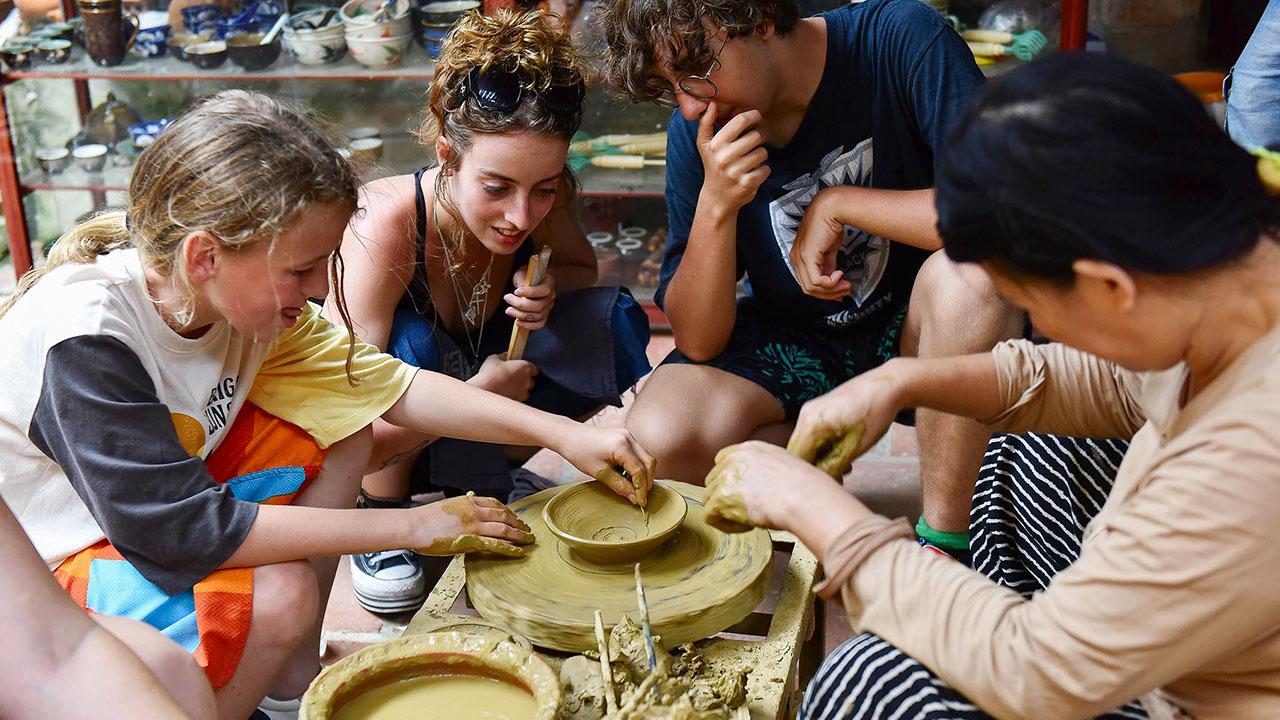
Types of Pottery Products
Bat Trang Pottery Village is a treasure trove of ceramic variety, reflecting the diverse techniques and creative evolution witnessed over centuries. The products crafted here embody both artistic flair and practical utility, catering to a wide range of tastes and preferences. Each piece, whether decorative or functional, is a testament to Bat Trang’s skillful artisanship and innovative spirit, ensuring the village remains a center of ceramic excellence.
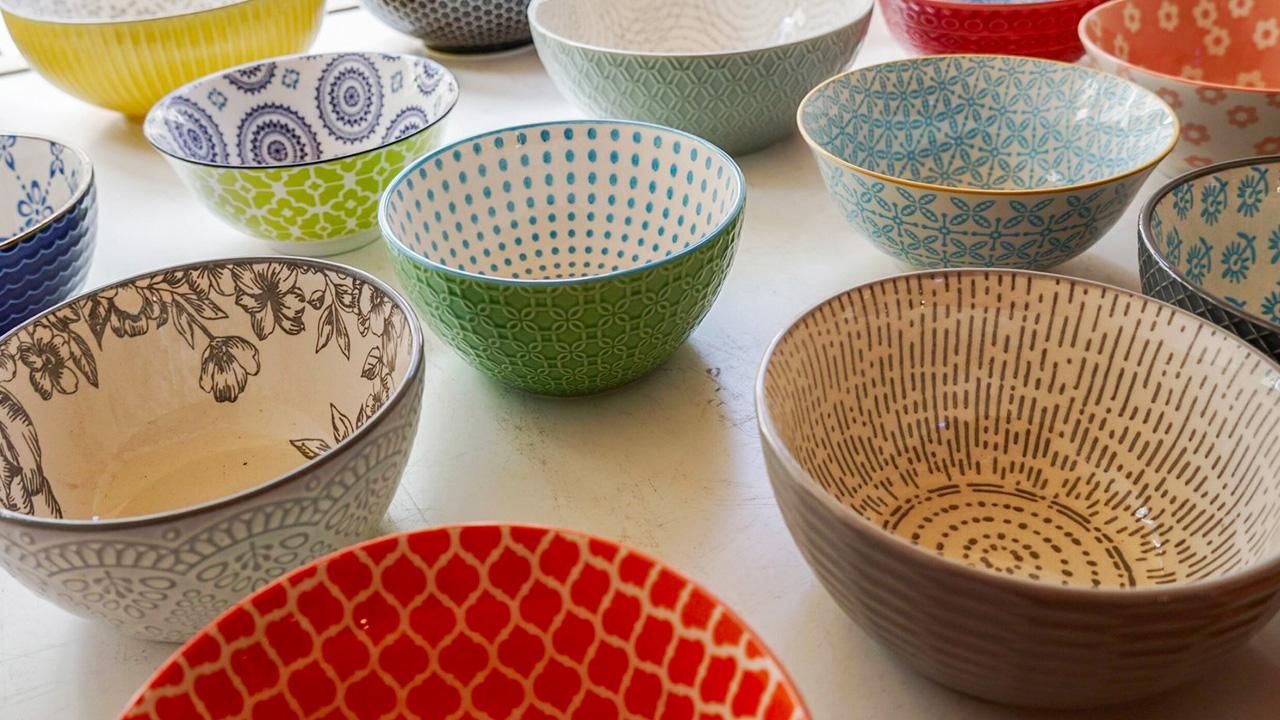
Decorative Pottery Items
Decorative pottery from Bat Trang is an exhibition of intricate craftsmanship and artistic expression. This subset of Bat Trang’s ceramic production emphasizes artistry and design over utilitarian function, showcasing the creative prowess of its artisans.
Popular decorative items include vases and sculptures, frequently adorned with motifs inspired by Vietnamese folklore, nature, and spiritual themes. These motifs, often detailed and vibrant, are achieved through advanced painting and glazing techniques. Some vases may feature ornamental floral patterns or phoenix and dragon designs, symbolizing prosperity and power, while others echo the serenity of nature with pastoral scenes.
Particularly unique to Bat Trang are porcelain murals and large-scale ceramic installations, which often find homes in temples and cultural exhibits. These items emphasize large canvases, where artisans can fully explore narrative storytelling through ceramic art. Each piece not only serves the aesthetic purpose but also conveys deeper cultural and historical narratives, making them valuable for cultural preservation.
Collectors often esteem Bat Trang’s decorative items for their artistic complexity and the skill they represent. Such items transcend utility, offering aesthetic pleasure and cultural storytelling, reflecting Bat Trang’s enduring legacy as an epicenter for fine ceramics.
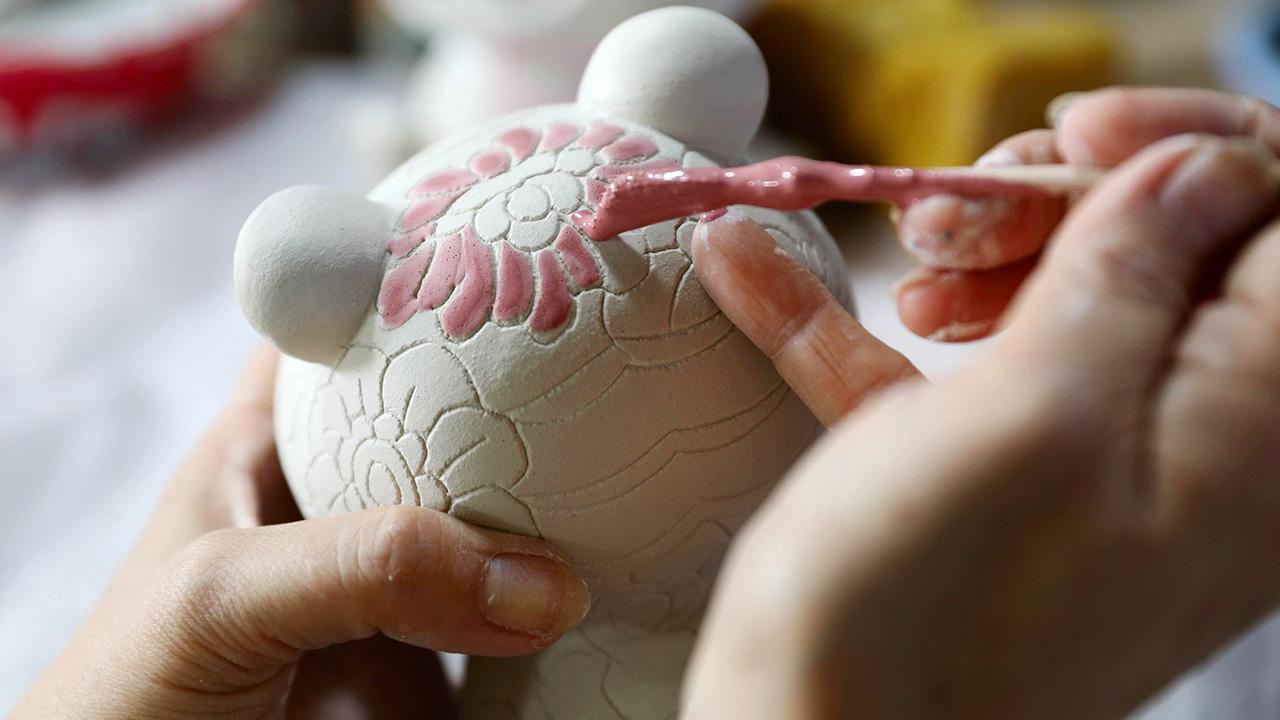
Functional Pottery Products
Functional pottery from Bat Trang is an integral part of daily life for many, embodying both practicality and elegance. This category includes a wide range of household items designed for everyday use, crafted with the precision and artistry that make Bat Trang ceramics so esteemed.
Notable functional items include:
- Tableware: Plates, bowls, and teacups are ubiquitous, lovingly crafted to be both useful and visually pleasing. These pieces often feature traditional blue and white designs, an homage to Chinese influences adapted into unique Vietnamese patterns. The thickness of Bat Trang’s tableware distinguishes it from counterparts, ensuring durability and longer life.
- Kitchenware: Such as kettles and serving dishes are crafted with attention to detail, ensuring functionality. These items often incorporate ergonomic designs that reflect a deep understanding of the interplay between form and utility.
- Vases and flowerpots: These are not only decorative but serve practical needs in homes and gardens. These items, while utilitarian, mirror the artistic qualities of Bat Trang through their ornate detailing and elegant glaze finishes.
The blending of form and function in Bat Trang’s functional pottery renders each piece a work of art in its own right, ensuring that even the most utilitarian items bring elegance and culture into everyday life. Artisans’ dedication to quality control ensures that these products meet high standards, reaffirming Bat Trang’s role as a reputable center for superior ceramics.
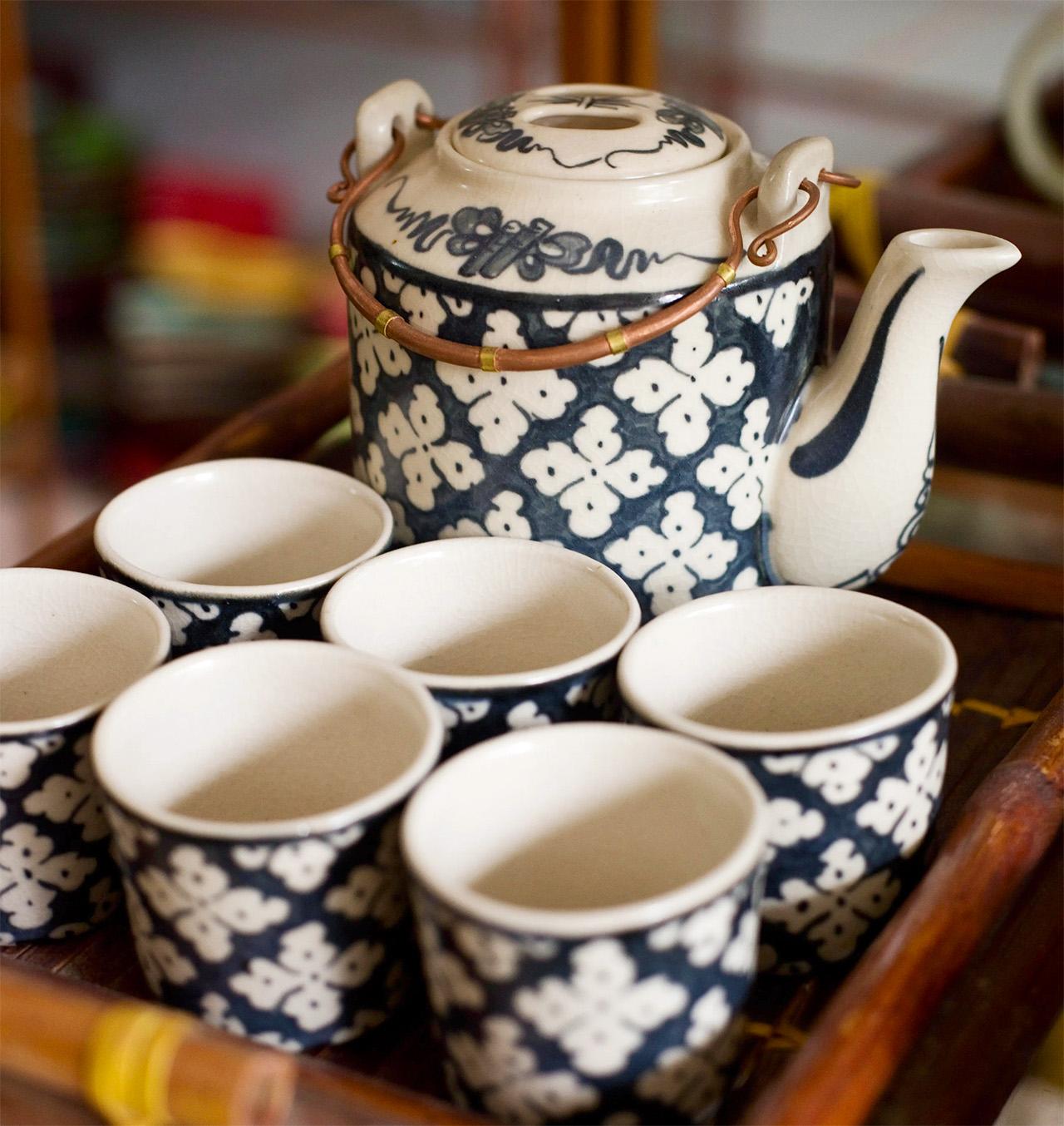
Custom and Personalized Pottery Options
The ability to customize pottery in Bat Trang adds a personal touch, making it an attractive option for those seeking unique, bespoke pieces. Customization is not just about the visual appeal; it’s a collaborative process between the artist and the customer, blending creativity and personal expression.
Bat Trang artisans offer a variety of personalized options, allowing customers considerable freedom in design. From choosing specific glaze finishes whether akin to a classic celadon or modern metallic hues to selecting forms and motifs, clients can tailor their pottery to suit their aesthetic or sentimental preferences.
The process of customization often involves an initial consultation with the artist, where ideas are exchanged, ensuring the client’s vision is understood and translated into the ceramic medium. This process might include selecting patterns or themes that resonate personally or match a specific interior decor.
Customer participation is also encouraged in workshops, where under guidance, visitors can create their own pottery pieces, adding a layer of personal craftsmanship. These workshops have become a sought-after experience, offering participants a tactile connection to the pottery-making process and an intimate keepsake from Bat Trang.
Custom and personalized pottery not only diversifies Bat Trang’s offering but also strengthens its ties to clients, turning a ceramic purchase into an interactive and meaningful experience. Each customized piece carries a narrative of collaboration and creativity, a testimony to the enduring relationship between artisan and consumer.
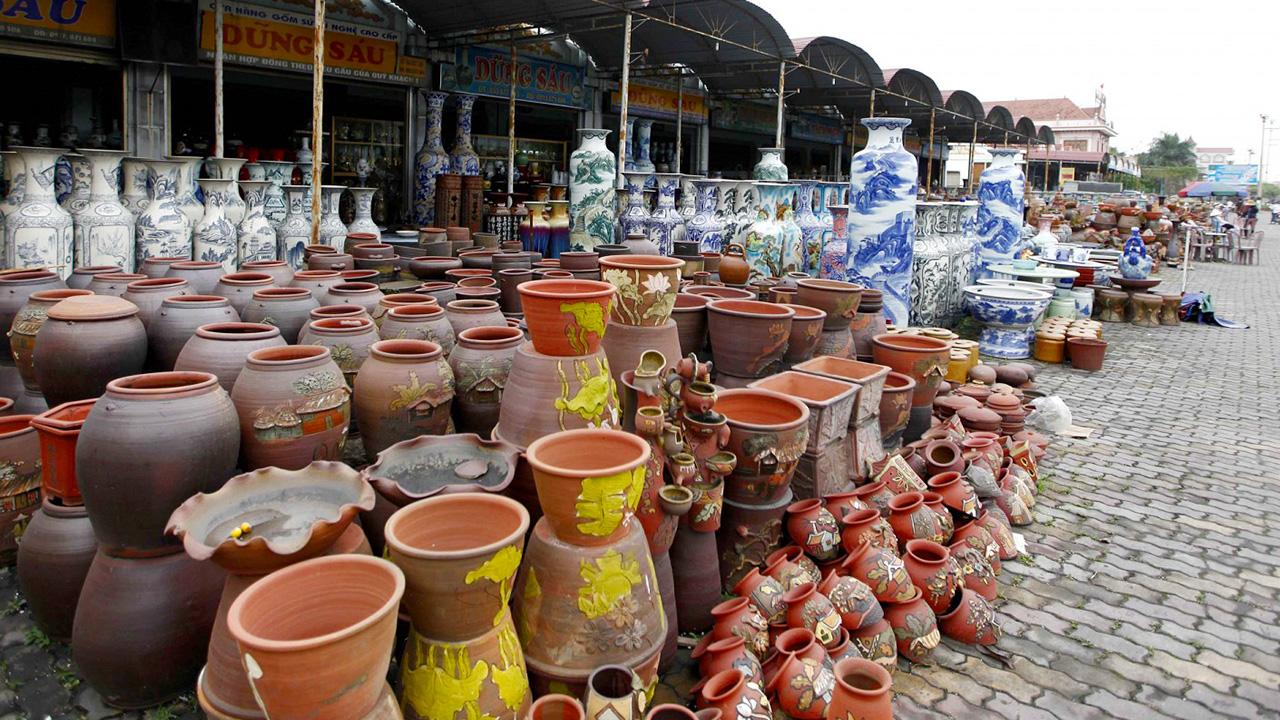
Cultural Significance of Bat Trang
Bat Trang pottery holds a central place in Vietnamese culture, serving as both a practical utility and a medium for artistic expression. Its ceramics reflect the country’s cultural fabric, woven with a rich blend of tradition, symbolism, and aesthetic beauty. With its products gracing households and its influence echoing through festivals and art, Bat Trang remains a keystone of Vietnam’s cultural identity.
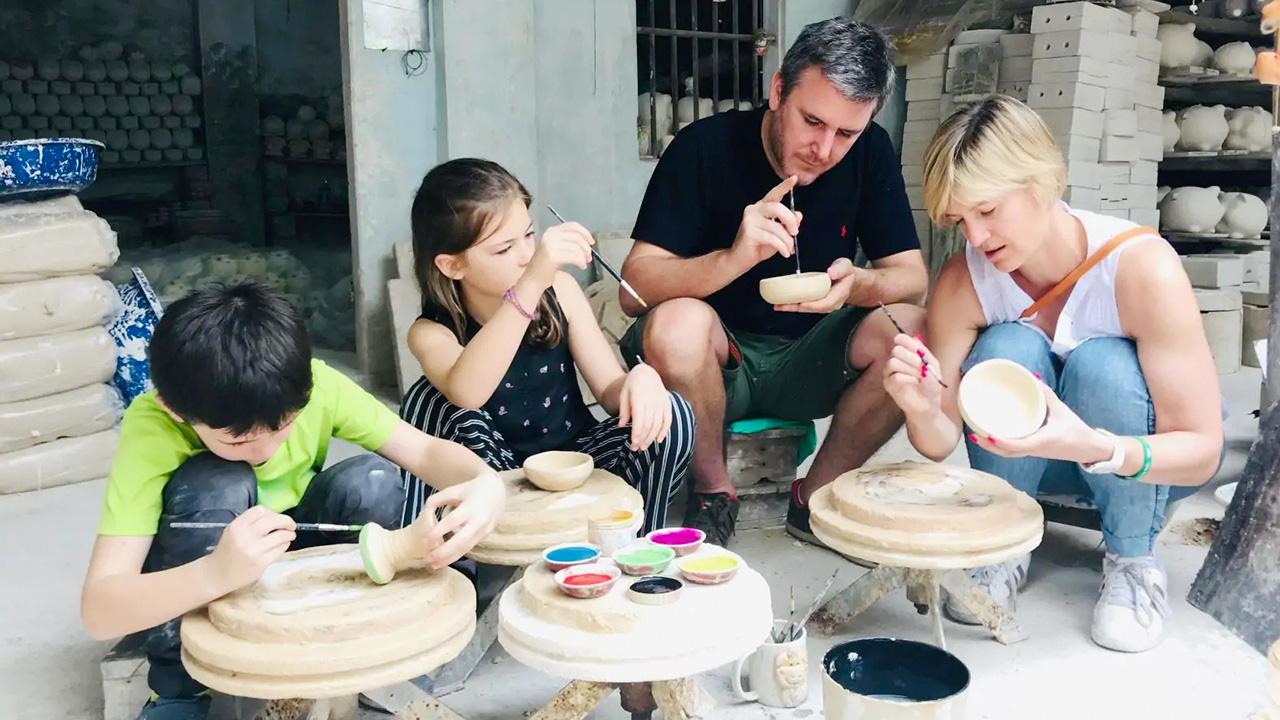
Role of Pottery in Vietnamese Culture
Pottery in Vietnam transcends mere function; it’s an embodiment of cultural values and traditions deeply rooted in the society. Bat Trang pottery, as a quintessential representative, plays a pivotal role in rituals, religious practices, and cultural celebrations, symbolizing aesthetic sophistication and historical continuity.
Key roles include:
- Religious and Ancestral Ceremonies: Pottery items like incense burners and offering bowls are integral in worship and rituals, connecting communities to their spiritual roots and ancestors, embodied within the serene art forms.
- Social and Communal Events: Ceramics often feature in celebrations such as weddings and Tet, Vietnam’s Lunar New Year, characterized by items reflecting prosperity and blessings, resonating with themes of renewal and happiness.
- Cultural Expression: Pottery also serves as a vehicle for artistic expression, with designs that narrate stories from Vietnamese folklore and history. This cultural storytelling preserves identity and heritage, immortalized in ceramic canvases.
Ultimately, Bat Trang pottery functions as an artistic dialog between past and present, reinforcing cultural identity and the artisans’ spirit. Its artistry adorns daily life with beauty and serves as a custodian of heritage, mirroring Vietnamese society’s intricacy and depth.
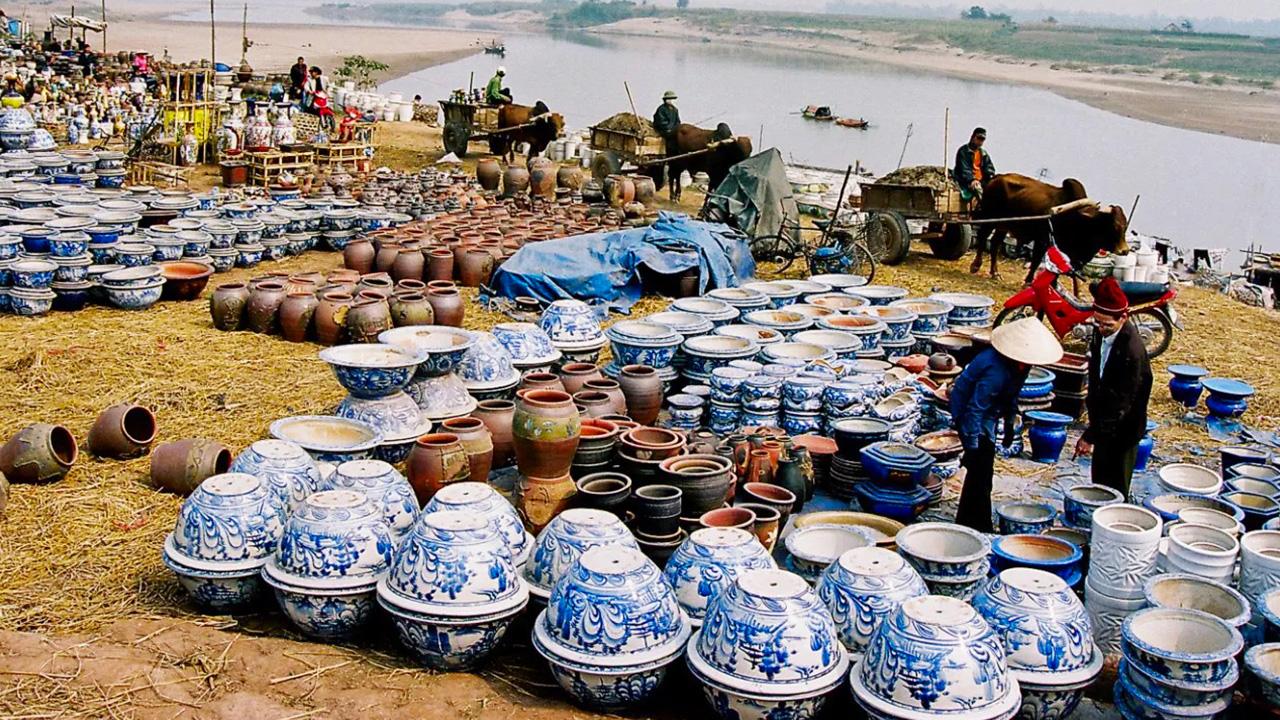
Festivals and Events Celebrating Pottery
Bat Trang’s vibrant traditions are showcased in its festivals and events, each a celebration of pottery and culture, drawing attention both locally and from afar. These events are not only showcases of craftsmanship but rich cultural tapestries that celebrate the vibrant heritage of Bat Trang’s artisans.
Among the most celebrated is the Bat Trang Ceramics Festival, held annually, coinciding with the Lunar New Year festivities. This event is an exploration of artistry where locals and tourists alike immerse themselves in workshops, exhibitions, and cultural performances. Artisans display their finest pieces, from historic reproductions to contemporary interpretations, creating a living exhibition of traditions and innovation.
Interactive activities are a festival highlight, including hands-on pottery sessions where participants can engage directly with the craft. These workshops provide insight into the intricate processes behind Bat Trang ceramics, allowing deeper appreciation and firsthand connection to the village’s artistic heart.
Food fairs are often paired with the ceramics displays, offering an authentic taste of local cuisine, which complements the artistic journey with flavors deeply tied to the region’s culture. Together, these festivals and events are a celebration of Bat Trang’s unwavering cultural spirit, fostering community pride and engaging visitors with a profound appreciation for the village’s enduring legacy.
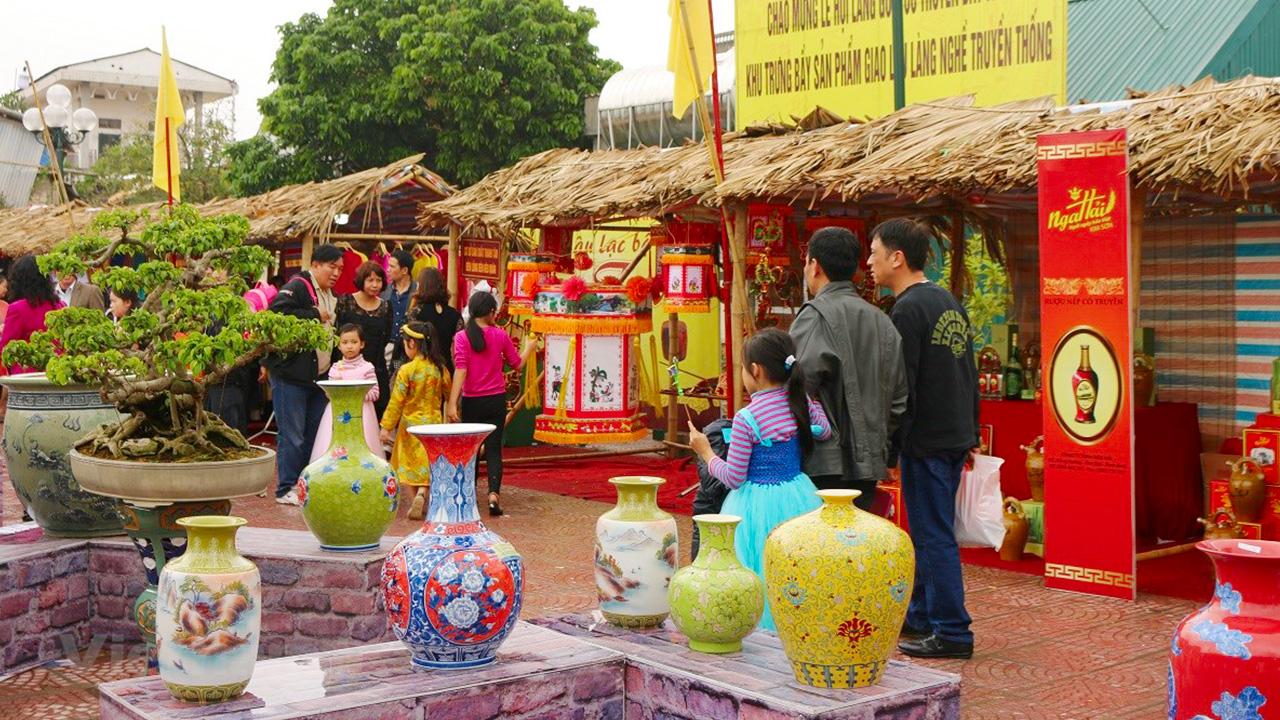
Influence of Bat Trang Pottery on Local Art
Bat Trang pottery exerts a considerable influence on local art, acting as a seedbed for innovation and tradition that impacts broader Vietnamese artistic expressions. The relentless pursuit of excellence by Bat Trang artisans has propelled it into an influential position where it shapes artistic narrative locally and inspires national ceramic artistry.
The distinct motifs and techniques honed in Bat Trang often inform broader trends in Vietnamese art. For example, the village’s hallmark crackled glazes and vibrant cobalt finishes frequently appear in other artistic media, such as textiles and wood carvings, while the themes represented in pottery designs are mirrored in paintings and traditional costume patterns, showcasing a seamless fusion of utility and art.
Moreover, Bat Trang serves as an inspiration for emerging artists. Through workshops and collaborative projects supported by art institutions, aspiring artisans are exposed to Bat Trang’s rich legacy, melding historical techniques with modern interpretations. This fusion results in an ever-evolving artscape that retains authentic roots while embracing innovation.
The ceramic tradition instilled by Bat Trang acts as a cultural beacon, perpetuating Vietnam’s artistic identity in the global arena, underlining heritage, and vibrantly infusing traditional Vietnamese culture into contemporary art forms.
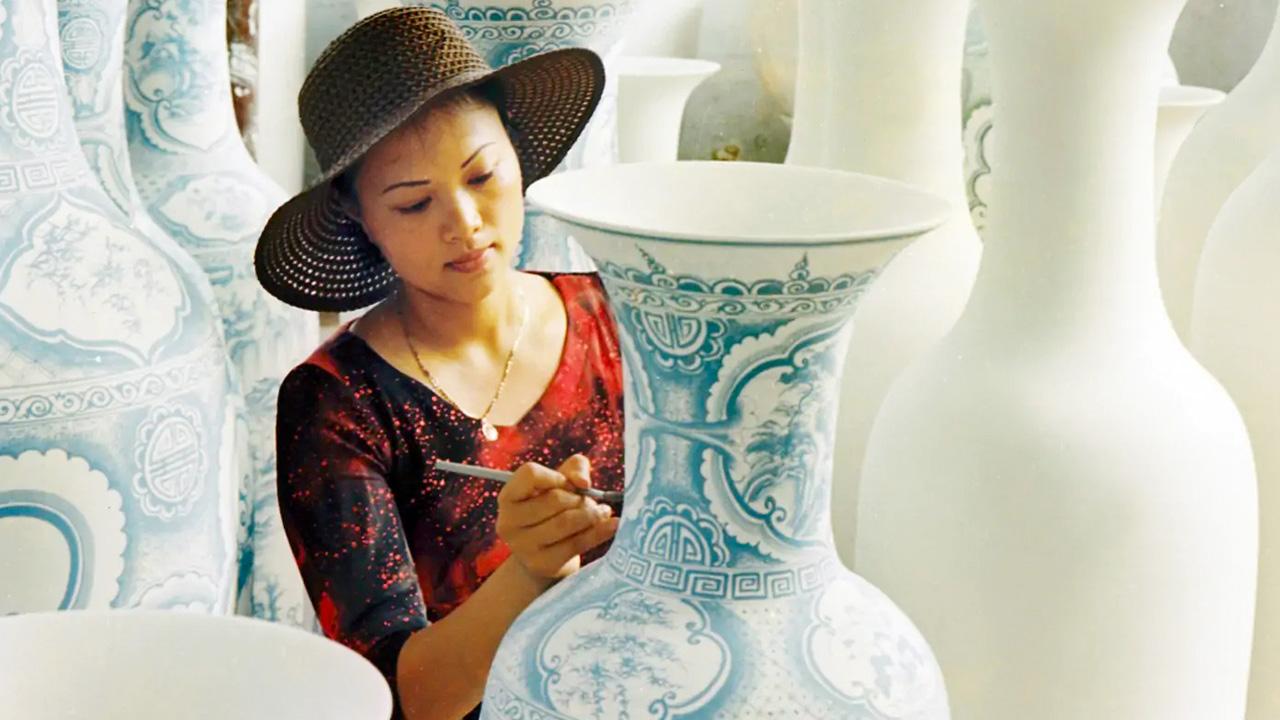
Visiting Bat Trang Pottery Village
Bat Trang, a cultural beacon, warmly invites visitors to immerse themselves in the artistry and history that define this unique village. Experiencing its vibrant culture and engaging with its artisans provides a multifaceted understanding of the deep roots and contemporary expressions that make Bat Trang an essential destination for all who cherish art and history.

Best Time to Visit Bat Trang
Understanding the best time to visit Bat Trang enhances the experience, allowing visitors to fully immerse themselves in its rich cultural landscape. The ultimate time to explore this village is between September and April, coinciding with cooler, drier weather conducive for travel and outdoor activities. During this period, guests can navigate the quaint lanes filled with artisan shops and workshops comfortably, unhindered by rain.
Visiting during the Lunar New Year also affords an enriched experience. The village buzzes with festivities, from interactive pottery-making sessions to cultural performances that showcase local traditions and culinary delights. This celebration brings to life Bat Trang’s vibrant spirit, blending the traditional with the contemporary a perfect illustration of the locality’s dynamic cultural dialogue.
Months outside the rainy season also allow for extensive exploration of nearby attractions, such as the Bat Trang Pottery Market, and provide a chance to savor local culinary offerings, heightening the cultural immersion. Thus, timing a visit optimally can make a profound difference, transforming a simple trip into an unforgettable exploration of art and culture.
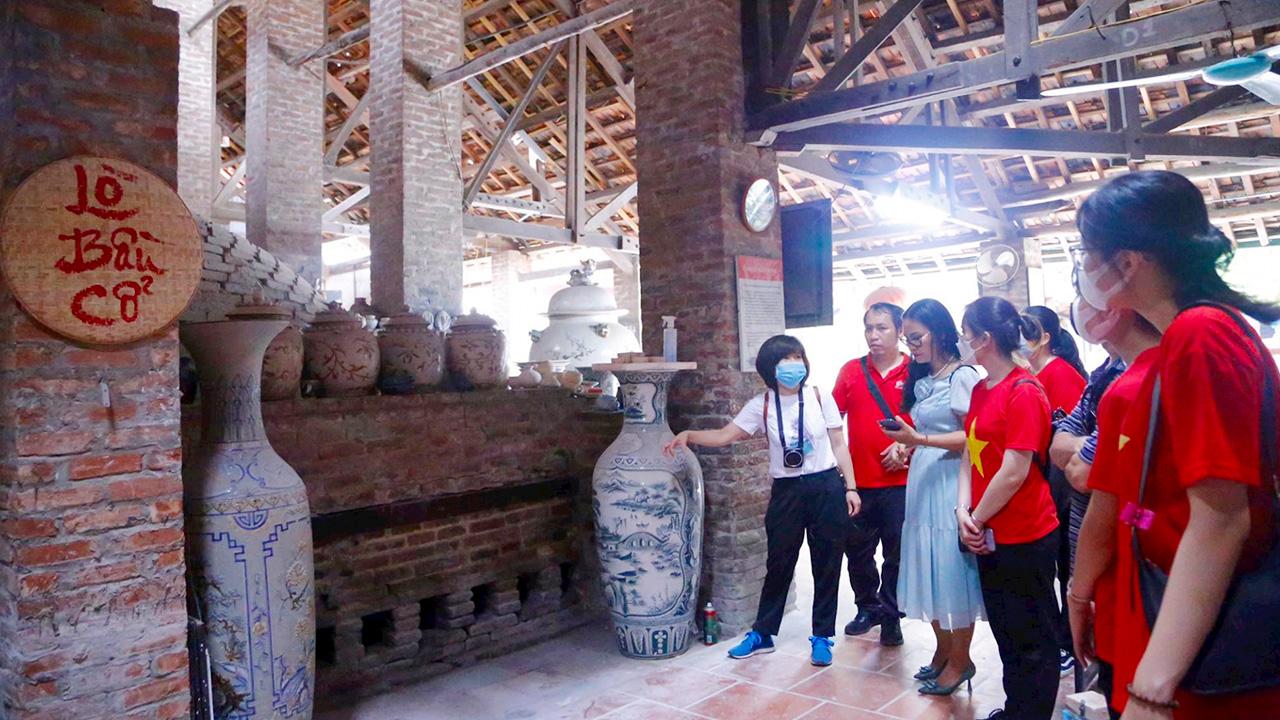
Guided Tours and Pottery Workshops
Bat Trang extends a warm welcome to all enthusiasts through its guided tours and hands-on pottery workshops, ensuring an immersive experience into the ceramic heart of Vietnam. These activities are thoughtfully curated to offer visitors an intimate understanding of Bat Trang’s renowned artistry and craftsmanship, with multiple options tailored to individual desires and group interests.
Tours typically include visits to local factories and artisan houses, where detailed demonstrations and storytelling convey the village’s rich history. As you observe artisans at work, crafting their ceramics through time-honored methods, you’re invited to witness the seamless blend of traditional and modern techniques.
Workshops, open to all skill levels, provide a unique platform for guests to mold, shape, and design their pottery pieces. Under expert guidance, participants engage with clay, learning first-hand the delicate balance of craft and artistry pervading Bat Trang’s legacy. The workshops result in personalized creations, offering both a creative outlet and a tangible memento of the experience.
These tours and workshops align artistic appreciation with educational enrichment, deepening the connection between visitor and artisan, inspiring respect and admiration for Bat Trang’s enduring ceramic heritage.
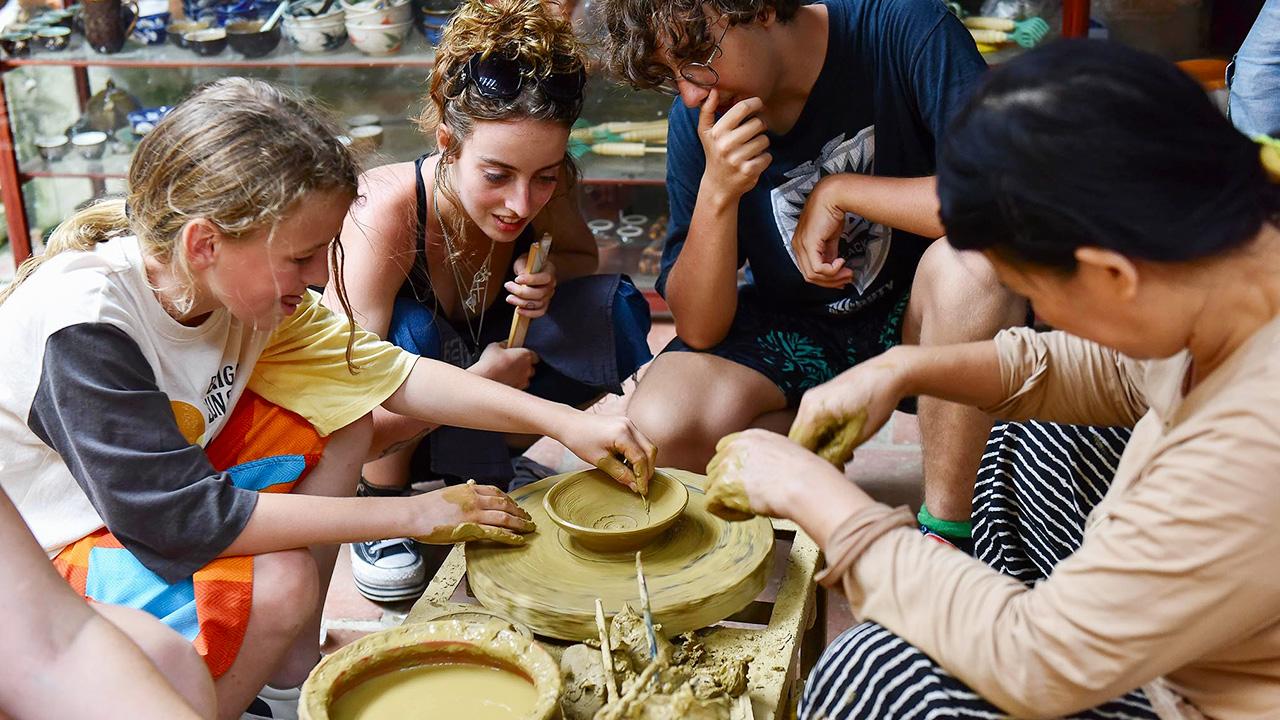
Local Cuisine and Attractions Nearby
A visit to Bat Trang is incomplete without indulging in its local cuisine and exploring nearby attractions, which collectively amplify the cultural immersion into the vibrant village lifestyle. Bat Trang’s culinary offerings include traditional Vietnamese dishes, offering flavors that are as wholesome and diverse as its ceramics.
Indulge in Pho, the iconic Vietnamese soup or savor the fresh flavors of spring rolls. The local eateries serve these delights alongside regional specialties like bamboo shoot soup, each dish a testament to the village’s culinary art. These food experiences integrate seamlessly with the artistic journey, satisfying the palate while nurturing an appreciation for local tradition.
Nearby attractions complement the pottery exploration, offering diversified experiences. Museums dedicated to ceramics showcase the history and evolution of the craft, while the pottery market provides an interactive shopping experience with opportunities to purchase or commission unique pieces directly from the artisans.
Together, these experiences ensure that a visit to Bat Trang is not just about witnessing art; it’s a celebration of local culture, where pottery, food, and history intertwine to offer a memorable and enriching cultural festival.

Comparison with Other Pottery Villages
In the rich tapestry of Vietnam’s pottery tradition, Bat Trang holds a unique place, steeped in centuries of skilled artisanship that intertwines cultural and artistic majesty. When compared to other pottery villages within Vietnam, Bat Trang stands distinctively, offering a diversity in style, technique, and market reach, making it a cornerstone in the country’s ceramic heritage.
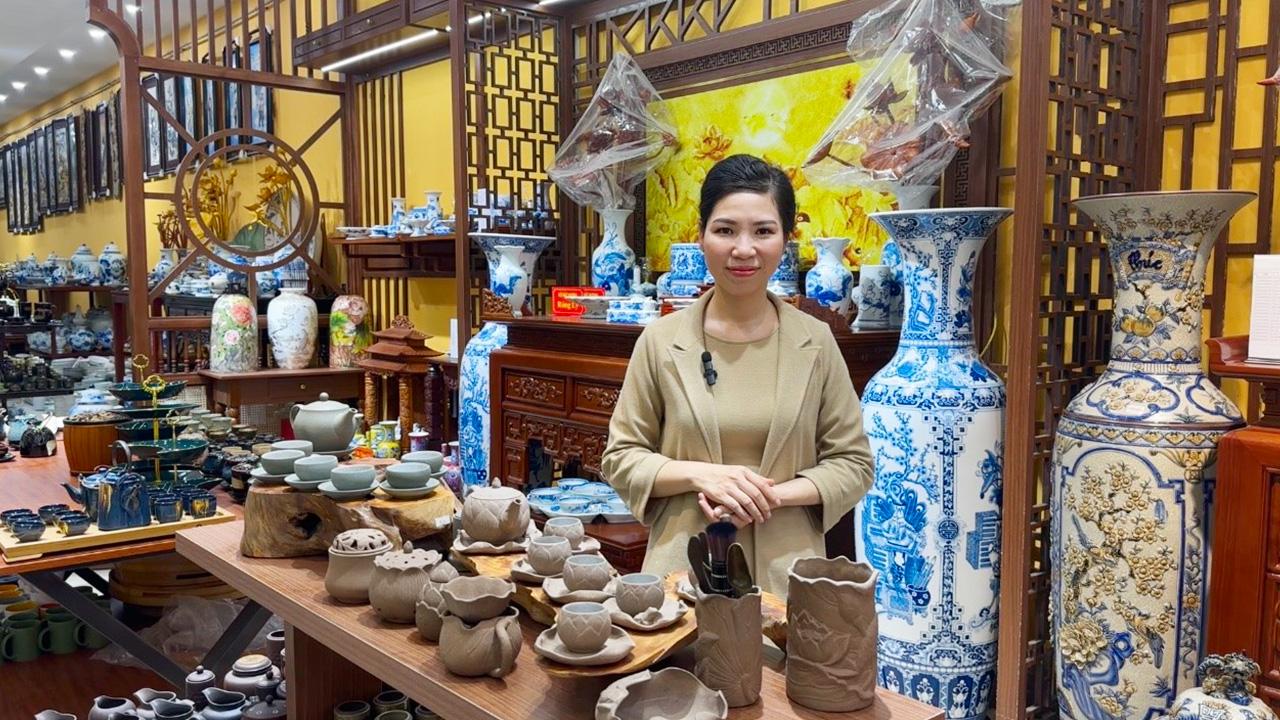
Bat Trang vs. Thanh Ha Pottery Village
The contrast between Bat Trang and Thanh Ha Pottery Villages paints a vivid picture of Vietnam’s diversity in ceramic artistry. Each village presents a unique narrative, showcasing deep-rooted traditions and local adaptations in pottery-making practices.
Bat Trang Village is notably known for its intricate designs and variety in ceramic products, from daily utility items to high-art decorative pieces. The use of prominent white clay enables Bat Trang artisans to craft fine porcelain with vibrant glazes, such as the distinctive blue and white patterns characteristic of this village. Meanwhile, Bat Trang embraces a blend of traditional craftsmanship infused with modern technologies, catering to both local and international markets with innovative designs.
On the flip side, Thanh Ha Village, found near Hoi An, focuses predominantly on terracotta products. The characteristic red clay of Thanh Ha gives its ceramics a rustic charm, with an emphasis on hand-crafted, utilitarian goods reflective of Vietnam’s rural life. The village is celebrated for its earthy sculptures and functional household wares, crafted traditionally to prioritize durability and cultural authenticity.
Visitors to these villages experience a sensory journey through time-honored craftsmanship and varied stylistic approaches. Bat Trang and Thanh Ha, while sharing the common thread of Vietnamese pottery heritage, display divergent artistic philosophies and methodologies that collectively enrich Vietnam’s pottery landscape.
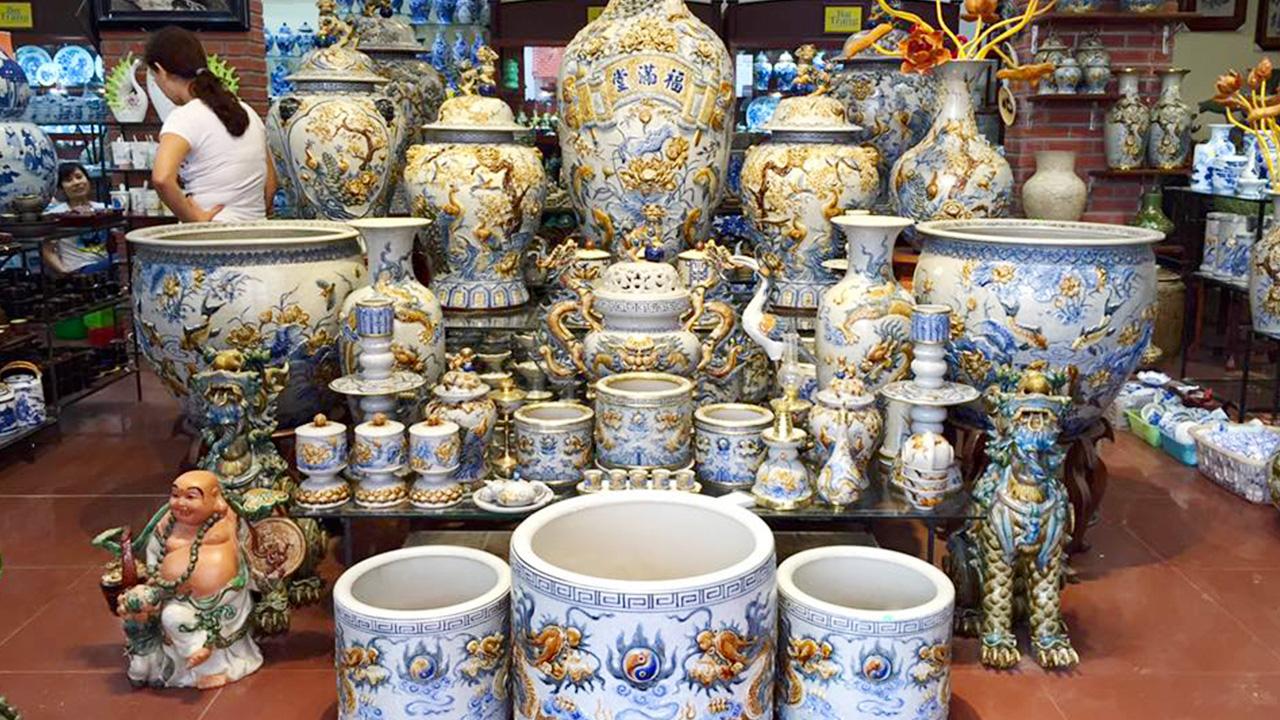
Differences in Style and Technique
The stylistic and technical disparities between different Vietnamese pottery villages underpin a fascinating study into regional artistic identity. In comparing Bat Trang with other pottery villages, these differences become strikingly evident, shaping each village’s unique offerings and artistic expressions.
Bat Trang’s artisans embrace a broad spectrum of styles, characterized by intricate detailing the use of underglaze blue and white motifs being particularly emblematic. Advanced glazing and firing techniques have evolved here, enhancing color vibrancy and design finesse, unlike other regions where natural red clay dictates simpler, robust forms. Advanced kiln technology and a keen eye for global design trends keep Bat Trang at the cutting edge, focusing on sophisticated aesthetics.
In contrast, villages like Thanh Ha lean into more rustic creations, prioritizing traditional hand-crafting techniques. Such villages often favor simplistic, yet durable and functional ceramic products, emphasizing the pottery’s utility within Vietnamese rural contexts. The technique is more about preserving antiquity, passed down unchanged, showcasing the steadfastness of Vietnamese cultural roots.
These stylistic differences offer a window into each village’s cultural essence and market approach. Bat Trang pushes artistic boundaries, capturing international audiences with contemporary designs while other villages highlight cultural conservancy, keeping ancestral crafts alive for domestic pride.
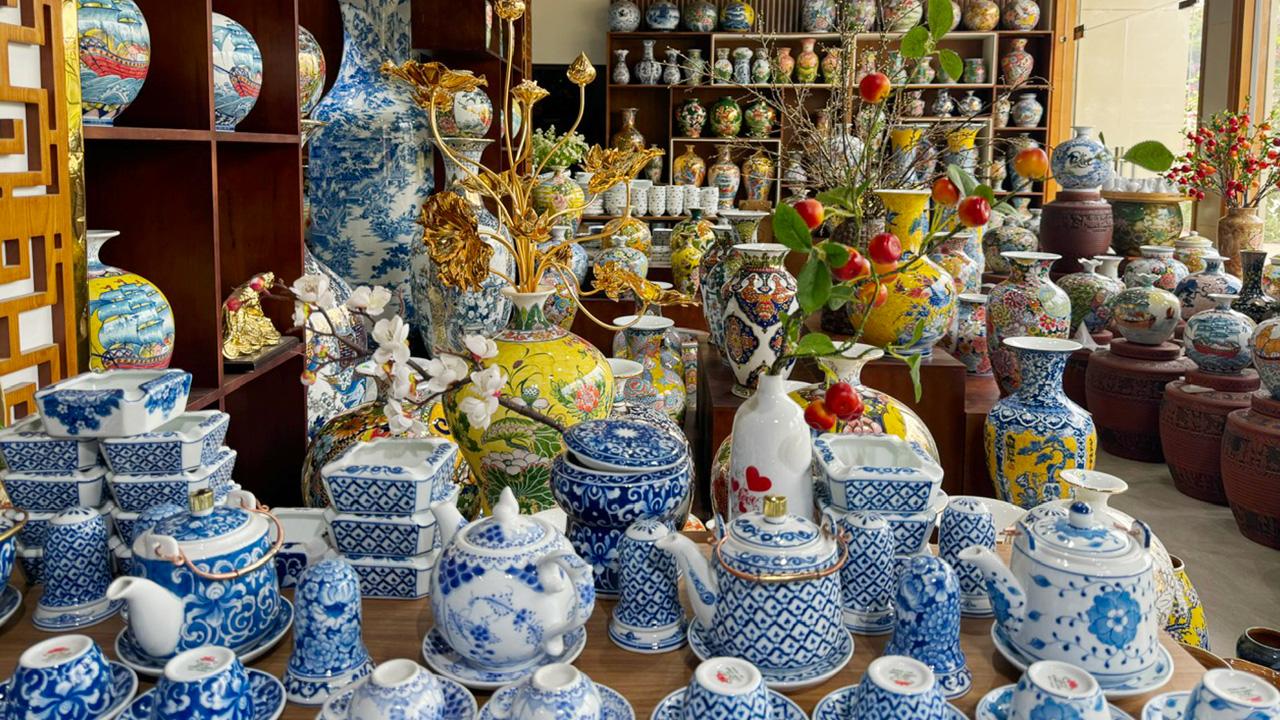
Market Demand and Export of Pottery
Bat Trang’s market strategy and global export success significantly diverge from other pottery villages, positioning it as a leader in Vietnam’s ceramic scene. The village has adeptly leveraged its reputation for quality and artistry to carve a niche in the international market, an achievement not similarly mirrored by all its contemporaries.
Notably, Bat Trang dominates in both local and international markets with diverse product offerings and competitive pricing, appealing to various consumer preferences. The strategic blend of traditional craftsmanship with modern innovation ensures the village consistently meets global design and quality standards, making its ceramics staples in home decor collections across continents.
In comparison, other pottery villages like Thanh Ha primarily serve local markets, maintaining a steadfast dedication to traditional styles without the same reach into international commerce. These villages prioritize small-scale operations and uphold cultural integrity over commercial expansion, meaning their market presence can be more restricted but deeply rooted in authentic craftsmanship.
This contrast underscores Bat Trang’s unique position not only as an artistic but also as a commercial powerhouse, setting benchmarks for market-driven adaptability alongside unwavering dedication to cultural heritage.
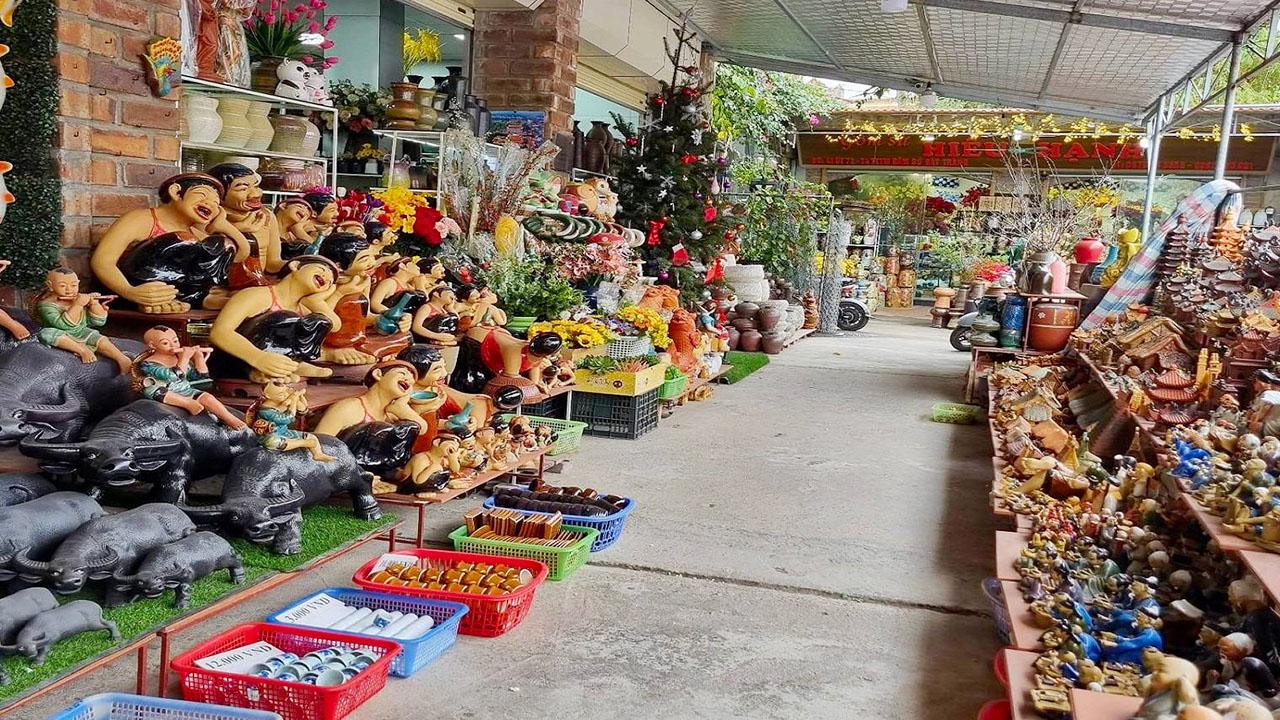
Sustainability in Bat Trang Pottery
In recent decades, sustainability has emerged as a priority within Bat Trang, guiding its practices towards eco-conscious pottery production. Cultural preservation, and a commitment to environmental responsibility, converge in locally rooted initiatives shaping the village’s future, ensuring that its ancient craft thrives amidst modern ecological demands.
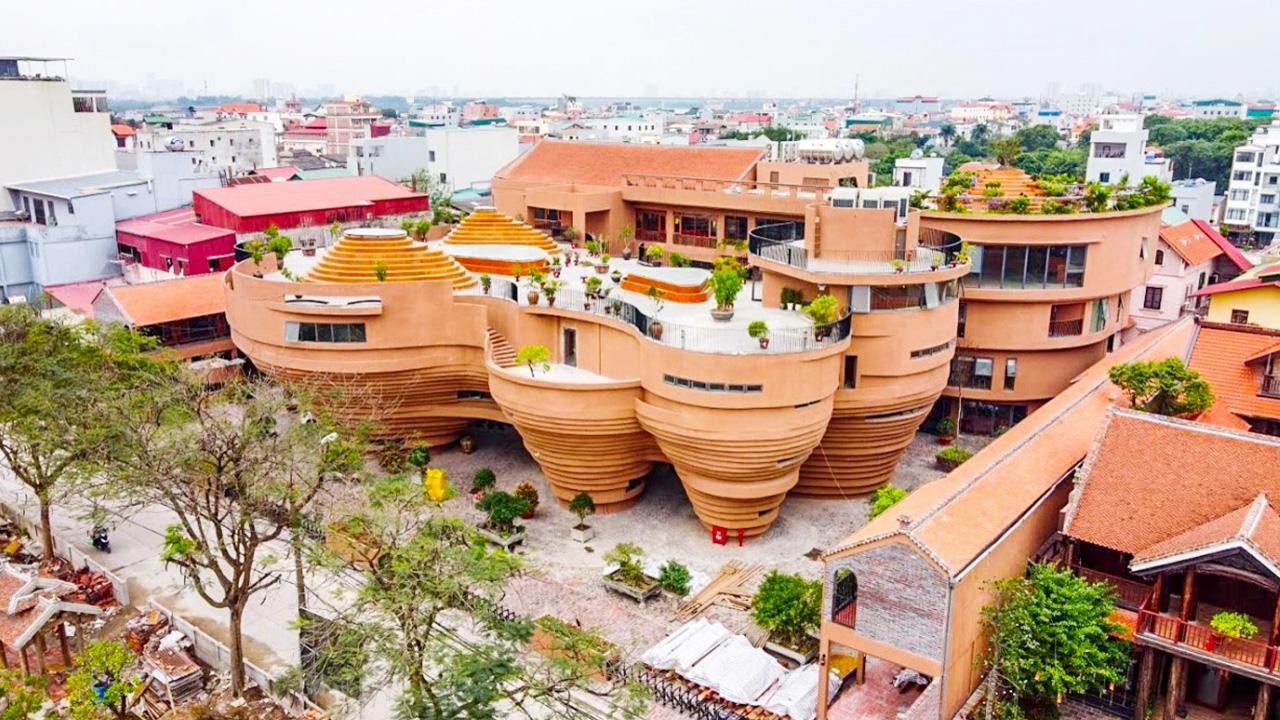
Eco-Friendly Practices in Pottery Production
Bat Trang’s shift toward eco-friendly practices highlights its commitment to sustainability while maintaining its traditional essence. The evolution from coal-powered kilns to energy-efficient electric systems marks a significant milestone in reducing the village’s carbon footprint, complimenting rising global environmental standards.
Sustainable approaches are evident in material sourcing, where artisans predominantly use locally abundant and renewable clay resources. Furthermore, non-toxic glazes and biodegradable packaging reflect initiatives to integrate eco-friendly innovations into the broader production process, ensuring the preservation of both artistic quality and environmental integrity.
Waste reduction is another focal point, with reclaiming broken pottery pieces and optimizing resources demonstrating responsibility. Community initiatives encourage collaborative efforts, transforming traditional methods into contemporary, green practices. Through environmentally conscious, culturally respectful production processes, Bat Trang continues setting the pace for sustainable artisanal craftsmanship.

Impact of Tourism on Local Pottery Production
Tourism has bolstered Bat Trang’s artisans economically and culturally, integrating visitors into the aesthetic fabric of the village, strengthening its legacy and ensuring longevity.
The exposure from tourism generates increased demand for local products, motivating craftspeople to innovate while preserving core traditions. Tourists actively participating in pottery workshops invigorate this experience, offering a practical understanding of Bat Trang’s artistry. The impact transcends revenue; it fosters a global appreciation for Vietnamese craft, fostering cross-cultural exchanges.
This influx enables economic upliftment and sustains local families dependent on pottery as a livelihood source. The active interplay between tourists and artisans emboldens them to explore innovative methods and adapt to global market trends, further intensifying their craftsmanship dedication. Tourism not only supports Bat Trang’s heritage but catalyzes its evolution, assuring its prominence in the artistic narrative.
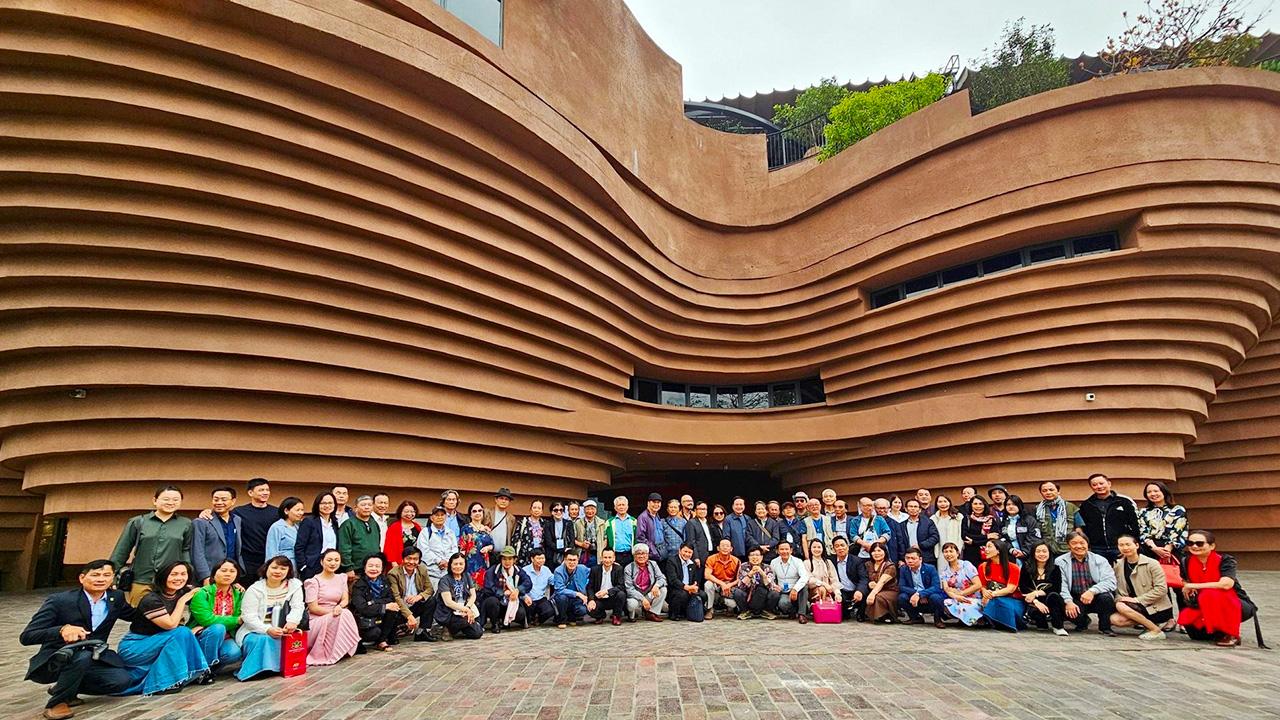
Community Efforts for Sustainable Development
Bat Trang’s community efforts towards sustainable development reflect a symbiotic relationship between ecological consciousness and artistic tradition. Spearheaded by local artisans and supported by regional initiatives, these efforts highlight a commitment to both societal well-being and environmental stewardship.
Educational programs are established to train new generations of potters in eco-friendly techniques, preserving the artisanal legacy while aligning with sustainable practices. Sustainable resource management initiatives advocate for responsible material use and reduction of waste, with community-led projects recycling and reusing materials innovatively.
Additionally, community collaboration fosters a creative ecosystem where ideas and practices are freely exchanged, nurturing not just art but a sustainable village lifestyle. It is through these holistic community efforts that Bat Trang reaffirms its pledge to sustainable development, ensuring its vibrant heritage and ecology thrive hand in hand.
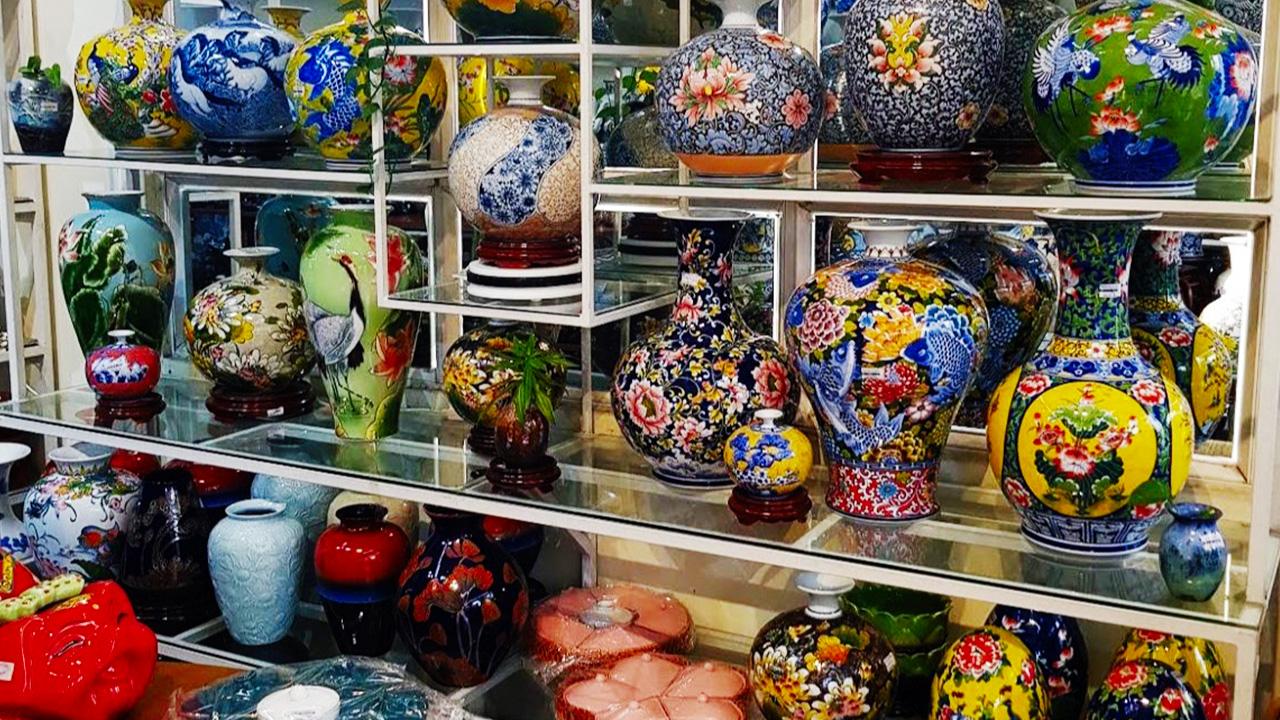
FAQs
- What makes Bat Trang pottery unique?
Bat Trang pottery is renowned for its intricate detailing, use of vibrant glazes, and its blend of traditional and modern techniques. - Can visitors participate in pottery making at Bat Trang?
Yes, Bat Trang offers hands-on pottery workshops for visitors of all skill levels, guided by local artisans. - What types of pottery products are most popular in Bat Trang?
Bat Trang is famous for both decorative items like vases and functional products like tableware, each displaying unique artistic qualities. - How does tourism impact Bat Trang’s pottery craft?
Tourism boosts local economy, supports artisans, and fosters cultural exchanges, increasing global appreciation for Bat Trang ceramics. - Are there eco-friendly practices in Bat Trang pottery production?
Yes, eco-friendly practices include using sustainable materials, electric kilns, and recycling processes to minimize environmental impact.
Key Takeaways
- Bat Trang is a historical pottery village, combining traditional methods with modern innovations.
- Intricate techniques and vibrant glazes define Bat Trang’s unique ceramic style.
- Tourism plays a crucial role in sustaining and promoting Bat Trang’s pottery tradition.
- The village prioritizes eco-friendly practices, reflecting a commitment to sustainable pottery production.
- Community efforts fuse ecological consciousness with artistic heritage, ensuring Bat Trang’s cultural and environmental sustainability.
Conclusion
Bat Trang Pottery Village, with its profound cultural heritage and innovative practices, remains a cornerstone of Vietnamese artistry and tradition. As you wander its lanes or engage in crafting a piece, you unearth stories molded by skilled hands over centuries. Bat Trang is more than a village of clay and glaze it’s a living museum of creativity and endurance. Its ability to evolve while preserving history makes it an emblem of cultural resilience, offering a vivid reflection of Vietnam’s artistic narrative. In a world increasingly drawn to authenticity and heritage, Bat Trang stands out as a beacon of enduring tradition and sustainable innovation, inviting all who visit to partake in its vibrant tapestry.


